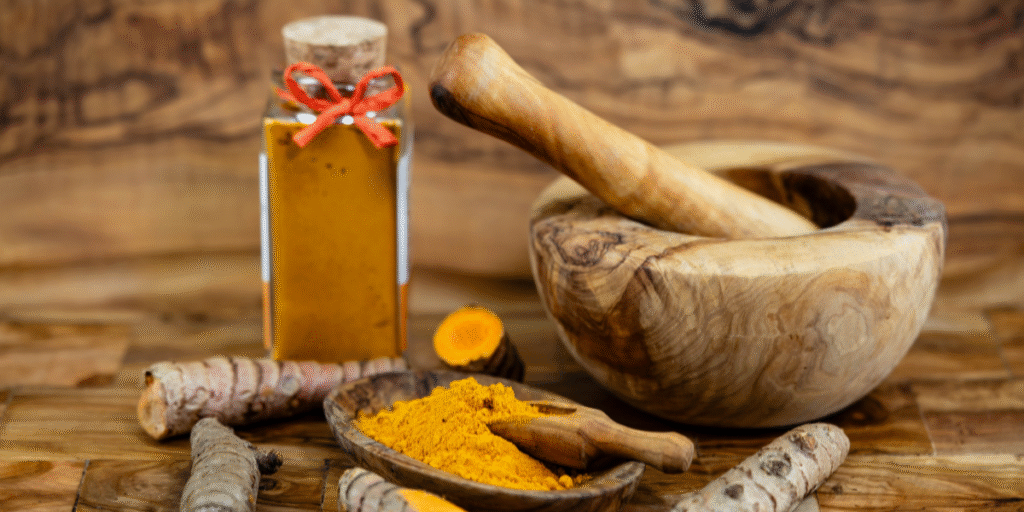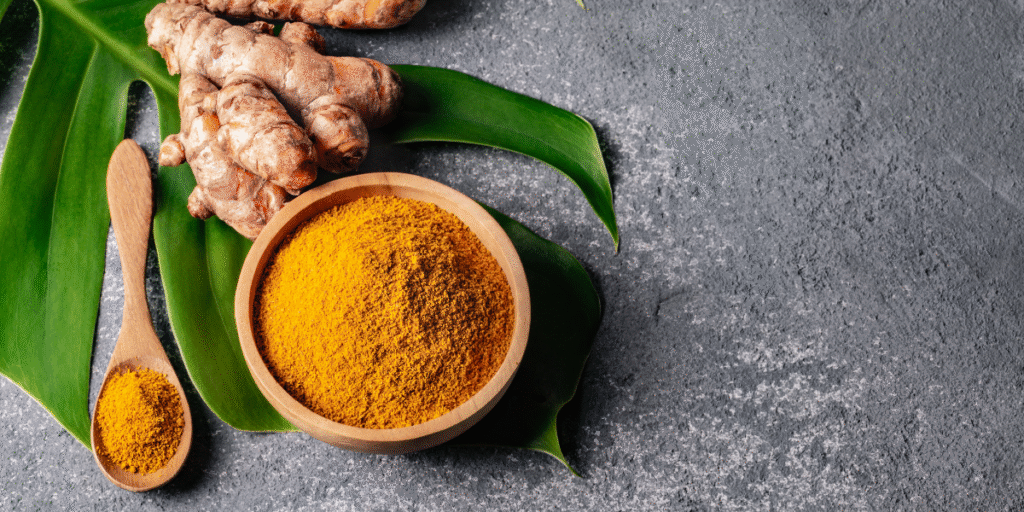Our Organic Turmeric Powder is carefully crafted from hand-selected, organically cultivated turmeric roots. After harvesting, the golden rhizomes are delicately peeled, slowly dried at temperatures below 40°C, and finely milled to preserve their natural vibrancy and potency. This mindful process helps retain turmeric’s essential nutrients, rich aroma, and brilliant color. Packed with the powerful active compound curcumin, this golden spice is treasured in Ayurvedic traditions and natural wellness for its rejuvenating and balancing properties.
Curcumin is the principal bioactive constituent of turmeric (Curcuma longa), comprising about 2 to 8% of the dry weight of the turmeric rhizome. It belongs to a family of compounds known as curcuminoids, which also include demethoxycurcumin and bisdemethoxycurcumin. Chemically, curcumin is a lipophilic polyphenol with the molecular formula C21H20O6 and a molecular weight of 368.38 g/mol. These characteristics contribute to its powerful antioxidant behavior and ability to interact with multiple cellular pathways in the body.
Curcumin is renowned for its broad spectrum of biological activities. It acts as a natural antioxidant, anti-inflammatory, antimicrobial, and anticancer agent, making it one of the most studied phytochemicals in modern science.
Scientific studies have demonstrated that curcumin plays a role in reducing the risk of arthritis, metabolic syndrome, cardiovascular disease, and certain cancers. It supports the body by modulating inflammatory enzymes, reducing oxidative stress, and improving immune response.
Curcumin’s potent antioxidant action helps delay signs of aging by protecting skin cells and tissues from oxidative damage. It promotes collagen production, skin elasticity, and reduces inflammation, contributing to overall vitality and youthful radiance.
While curcumin offers numerous benefits, its low aqueous solubility and limited bioavailability hinder its full potential. The body absorbs only a small percentage of ingested curcumin, making effective formulation essential.
Recent developments have led to enhanced curcumin delivery systems such as nanoemulsions, liposomal curcumin, and phytosomal complexes, which can increase absorption rates by up to 20 to 30 times compared to standard curcumin powder. These formulations improve stability, bioavailability, and overall therapeutic outcomes.
To ensure the purity and efficacy of curcumin products, advanced analytical tools are used, including HPLC (High-Performance Liquid Chromatography), LC-MS/MS (Liquid Chromatography–Mass Spectrometry), and FT-IR (Fourier Transform Infrared Spectroscopy). These methods allow accurate quantification of curcuminoids and verification of product quality, ensuring consistency and authenticity in nutraceutical formulations.

Turmeric (Curcuma longa) and ginger (Zingiber officinale) are close botanical relatives belonging to the Zingiberaceae family. Both plants are native to South and Southeast Asia, celebrated for their culinary versatility and medicinal value. While their rhizomes look similar, flavor profiles and key bioactive compounds set them apart.
At first glance, turmeric and ginger roots appear nearly identical—knobby, aromatic rhizomes with earthy undertones. Slicing or peeling, however, reveals vital differences. Turmeric displays a deep golden-yellow or orange hue due to its natural pigment curcumin, while ginger reveals a much paler, beige-yellow interior.
Ginger’s sharp, spicy, and warming flavor is ideal for adding heat and zest to dishes and teas. Turmeric has a milder, slightly bitter and earthy taste, perfect for curries, soups, and herbal blends with subtle depth.
Turmeric’s vibrant color is attributed to curcumin—a naturally occurring polyphenolic compound with strong antioxidant and anti-inflammatory activity. Curcumin is responsible for both turmeric's golden tone and its reputation as a wellness-enhancing spice in Ayurveda and modern nutrition.
Ginger’s signature bioactive is gingerol, known for its pungent, spicy flavor and therapeutic effects: easing digestion, reducing nausea, and supporting circulation. Curcumin and gingerol represent the unique chemical identities distinguishing these two roots.
Both turmeric and ginger have spread globally as kitchen and wellness staples. Turmeric naturally colors and enriches foods—golden curries, health tonics—while ginger boosts flavor and aroma in teas, desserts, and savory dishes.
When combined, turmeric and ginger create a functional synergy: turmeric’s anti-inflammatory curcumin and ginger’s digestive, immune-boosting gingerol. This duo is popular in herbal teas, superfood powders, and health tonics—symbolizing holistic wellness balance.
The golden turmeric latte, known as Golden Milk, is a modern revival of an ancient Ayurvedic tradition. Its rich color and soothing aroma make it a favorite among wellness seekers everywhere.
Golden milk has been a staple in traditional Indian households, blended from turmeric, milk, and spices for natural healing. Its use is rooted in fatigue relief, anti-inflammation, and seasonal colds. Today, it’s celebrated for both flavor and functional benefits.
“Golden milk” earns its name from curcumin's golden-yellow hue and an aroma that fuses sweet and spicy notes. Each sip is warm, restorative, and nourishing—a perfect drink for body and soul.
Golden milk is a caffeine-free, gentle energy boost. Blend oat milk, turmeric powder, black pepper, ginger, and cinnamon for a creamy beverage that supports digestion and immunity.
Turmeric latte embodies comfort and mindfulness. Whether on a chilly morning or cozy evening, it connects ancient tradition with modern wellness culture.

Our Organic Turmeric Powder is carefully crafted from hand-selected, organically cultivated turmeric roots. After harvesting, the golden rhizomes are delicately peeled, slowly dried at temperatures below 40°C, and finely milled to preserve their natural vibrancy and potency. This mindful process helps retain turmeric’s essential nutrients, rich aroma, and brilliant color. Packed with the powerful active compound [translate:curcumin], this golden spice is treasured in [translate:Ayurvedic] traditions and natural wellness for its rejuvenating and balancing properties.
[translate:Curcumin] is the principal bioactive constituent of [translate:turmeric (Curcuma longa)], comprising about 2 to 8% of the dry weight of the turmeric rhizome. It belongs to a family of compounds known as [translate:curcuminoids], which also include [translate:demethoxycurcumin and bisdemethoxycurcumin]. Chemically, curcumin is a lipophilic polyphenol with the molecular formula [translate:C₂₁H₂₀O₆] and a molecular weight of 368.38 g/mol. These characteristics contribute to its powerful antioxidant behavior and ability to interact with multiple cellular pathways in the body.
[translate:Curcumin] is renowned for its broad spectrum of biological activities. It acts as a natural antioxidant, anti-inflammatory, antimicrobial, and anticancer agent, making it one of the most studied phytochemicals in modern science.
Scientific studies have demonstrated that curcumin plays a role in reducing the risk of arthritis, metabolic syndrome, cardiovascular disease, and certain cancers. It supports the body by modulating inflammatory enzymes, reducing oxidative stress, and improving immune response.
[translate:Curcumin]’s potent antioxidant action helps delay signs of aging by protecting skin cells and tissues from oxidative damage. It promotes collagen production, skin elasticity, and reduces inflammation, contributing to overall vitality and youthful radiance.
While curcumin offers numerous benefits, its low aqueous solubility and limited bioavailability hinder its full potential. The body absorbs only a small percentage of ingested curcumin, making effective formulation essential.
Recent developments have led to enhanced curcumin delivery systems such as nanoemulsions, liposomal curcumin, and phytosomal complexes, which can increase absorption rates by up to 20 to 30 times compared to standard curcumin powder. These formulations improve stability, bioavailability, and overall therapeutic outcomes.
To ensure the purity and efficacy of curcumin products, advanced analytical tools are used, including [translate:HPLC (High-Performance Liquid Chromatography)], [translate:LC-MS/MS (Liquid Chromatography–Mass Spectrometry)], and [translate:FT-IR (Fourier Transform Infrared Spectroscopy)]. These methods allow accurate quantification of curcuminoids and verification of product quality, ensuring consistency and authenticity in nutraceutical formulations.